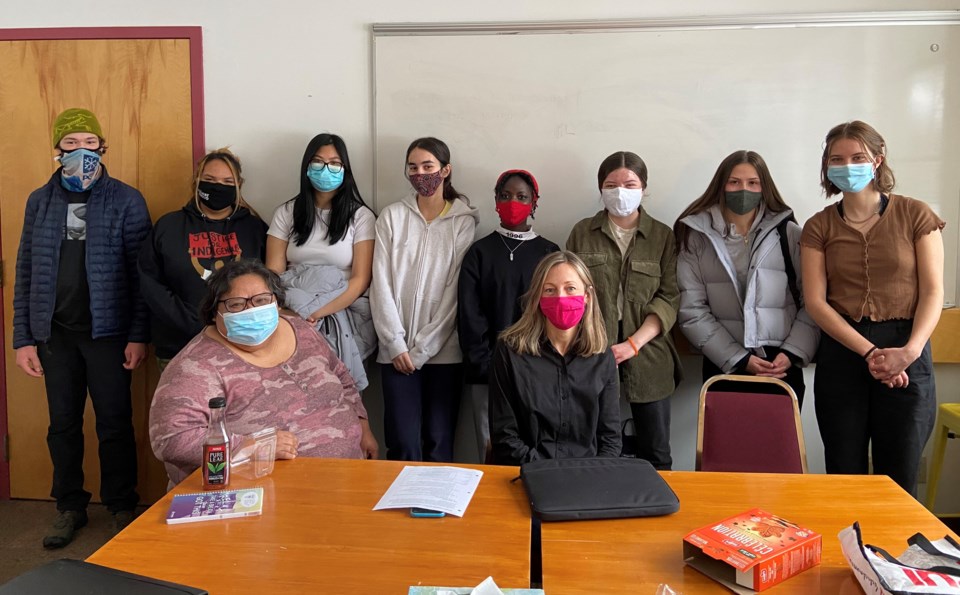A group of Whistler Secondary School (WSS) students have spent the last year working to define how their school community perceives racism in its hallways.
As they discovered through a recent survey, that understanding is varied.
These efforts began when the WSS Indigenous Leadership group—an extracurricular club which includes Grade 12 students Czachie Pescador, Makaila Machilek, Natilyn Edmonds, Janice Otieno, Kacey Cox, Sky Murgatroyd and Simona Kolvek—hosted a presentation on the topic in spring 2021.
(Students TJ Straver, Isabelle Chafe and Natalie Leaist joing the group—led by counsellor Clare Hanbury—after the project was already underway. WSS Indigenous Leadership students also work with Lil’wat Nation's Tanina Williams, and Indigenous cultural worker who supports the group’s learning.)
Initially, “We wanted to see how racism was affecting our school and what the viewpoints were for it,” said Machilek, but following the first presentation, “We came to the conclusion that we covered a lot of topics in a very short amount of time and we weren’t entirely sure just how well everybody had gotten the whole [concept].”
Following last spring’s presentation, the leadership group surveyed 275 Whistler Secondary students, providing definitions of terms like racism, white fragility, white privilege and microagressions, and asked respondents whether they see examples of these occurring at school. WSS Indigenous Leadership presented the survey’s results to their classmates this fall, before taking that same presentation to school board representatives prior to the holiday break.
“I think a lot of people, especially in our school, think racism doesn’t really exist in our school,” said Kolvek. “So sharing that information that we saw from the first survey ... was really shocking.”
The responses, more often than not, were split. Of those 275 students, 37.4 per cent said they’re not sure if they see racism at school, while 31 per cent said yes and 28.5 per cent said no.
When it comes to white fragility, 40.1 per cent of students polled said they’re not sure if they see examples of this at school, while 30.7 per cent said no and 24.8 per cent said yes. Meanwhile, 41.6 per cent of students said they weren’t sure if they see examples of white privilege at school, while 37.6 per cent said no and 17.2 per cent said yes.
Instances of microagressions—or “hurtful, subtle and discriminatory comments or questions to people of minority or marginalized groups,” as defined by WSS Indigenous Leadership, that “may often be told as compliments”—were apparent to 29.9 per cent of respondents, while 27.7 per cent said they don’t see these at school and 40.9 per cent said they’re not sure.
The survey also asked students if they’ve ever been called out for making an intentional or unintentional racist comment. While 65.7 per cent said no, 15 per cent said yes, they’ve been called out, while 17.9 per cent said they weren’t sure.
The survey allowed students to leave detailed comments, as well. Some respondents, explained Otieno, “basically admitted to doing racial acts and [saying] slurs ... but [said] it was just a joke, and they didn’t seem to think that it was an important, big thing.”
It was a topic the leadership group addressed in the presentation prior to the survey rollout, added Machilek. “[We] talked about how it’s not just a joke, it’s not a sense of humour. It’s something that is actually making an impact on somebody’s life in a horrible way,” she said. “So it was really crazy to see that people still didn’t get that, right after we had talked about it.”
As the project progressed, the leadership group agreed that sharing the information they gathered had an eye-opening effect on their classmates—both for students who’ve witnessed racism at play, and those who believed it was non-existent at Whistler Secondary.
This fall, the group opted to continue its efforts by assigning a project to every Career Life Class, tasking their classmates with researching a racial term, event or historical figure and presenting it in a format of their choosing, “whether it be a poster or essay, or they just wanted to talk about it, or an art piece,” explained Cox.
“When we put out the surveys, originally, people got really defensive and kind of felt like we were accusing them of something. But I think by the second presentation, people adjusted a bit more and got the idea that it’s more so about learning about it than accusing,” she said.
Added Machilek, “It’s OK if you mess up as long as you’re willing to take full responsibility for that and do better next time.
“That’s one of the things that we emphasize, because we didn’t want people to feel attacked because then the conversation isn’t going to get anywhere, if nobody feels open to it.”




